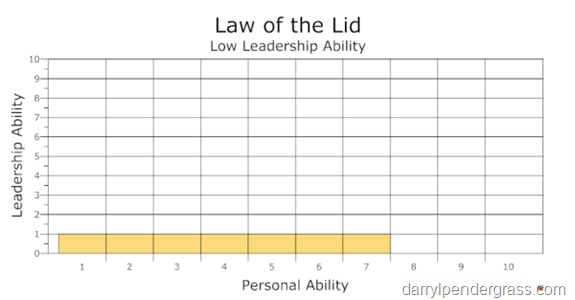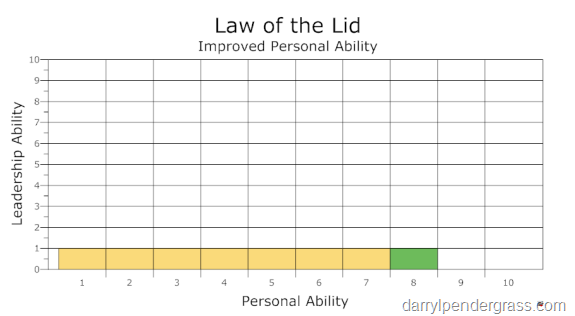In John C. Maxwell’s book The 21 Irrefutable Laws of Leadership: Follow Them and People Will Follow You, John discusses the effect of leadership toward improving one’s overall potential and personal effectiveness. Improving your personal effectiveness involves two major approaches. Improving your personal ability is the first approach and improving your leadership ability is the second.
This figure represents a person with relatively high personal ability but low leadership ability.
This person can improve personal effectiveness by focusing on improved personal ability. According to the Law of Diminishing Returns, at some point the applied effort exceeds the benefit received. As shown in the next figure, striving to improve your personal ability results in only a small return on your investment or a small improvement in your personal effectiveness.
Despite the small to moderate returns, many people focus on this approach to improve personal effectiveness for several reasons. First, this approach is comfortable because we tend to have more control over this method. Second, we tend to believe that doing things ourselves is the most expedient way to complete tasks. Third, after dedicating the time to improve our personal ability, we are often reluctant to share knowledge with others for fear of losing the edge we achieved through our dedication to personal excellence. However, striving to improve personal effectiveness in these ways lead to several problems. First, the approach returns smaller gains with increased effort. Second, if you always do things yourself, you will always have to do those things. Third, the margin of performance between you and your peers or competitors is often short lived. Personal effectiveness is limited without leadership ability.
The following figure shows the increased personal effectiveness by focusing on the second approach – improving leadership ability.
As shown, even moderate improvements in leadership ability result in significant improvement in personal effectiveness. Improving your ability to lead multiplies your personal effectiveness. Of course, this requires a change in the mindset discussed earlier because that mindset inhibits your personal growth. To reach higher levels of personal effectiveness, you must raise the level of the leadership lid.
Action Plan
What are your major goals? Write them down. If your major goals need the cooperation and participation of others, your leadership ability significantly effects your effectiveness or ability reach those goals.
Assess your leadership ability: the book includes a leadership assessment form but you can also search the Internet with the keywords “Leadership Assessment” to locate other forms and on-line assessments. Next, seek the input of others about your leadership ability. Comparing those inputs to your self-assessment provides a more objective assessment of your leadership abilities.
Prepare your leadership improvement plan. Use the results of the leadership assessment to plan the activities needed to improve your leadership ability and personal effectiveness, then follow the plan.
Links
Mind map of the 21 laws of leadership.
Leadership-tools.com
Managementhelp.org – overview of leadership in organizations
Reference
Maxwell, John. (2007). The 21 irrefutable laws of leadership. Nashville, TN: Thomas Nelson Publishers.




3 pings
[…] laws of leadership. Mind map of the 21 laws of leadership. Introduction to the leadership laws | 1 – The Law of the Lid | 2 – The Law of Influence | 3 – The Law of Process | 4 – The Law of Navigation | 5 – The […]
[…] laws of leadership. Mind map of the 21 laws of leadership. Introduction to the leadership laws | 1 – The Law of the Lid | 2 – The Law of Influence | 3 – The Law of Process | 4 – The Law of Navigation | 5 – The […]
[…] laws of leadership. Mind map of the 21 laws of leadership. Introduction to the leadership laws | 1 – The Law of the Lid | 2 – The Law of Influence | 3 – The Law of Process | 4 – The Law of Navigation | 5 – The […]